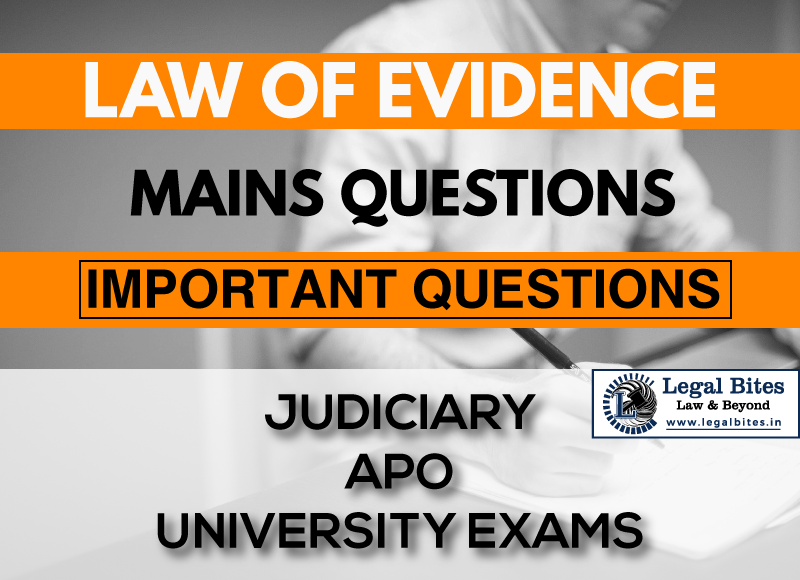Relevancy of statement made to Police Officer | A is tried for the murder of B…. Is the statement made by A to the police officer relevant under Section 25, 26, or 27?
Question: Relevancy of statement made to Police Officer | A is tried for the murder of B. The evidence is offered to show that A made the statement to a police officer while he was in police custody – it is the weapon by which he murdered B”. The same was told by the accused while the investigating… Read More »

Question: Relevancy of statement made to Police Officer | A is tried for the murder of B. The evidence is offered to show that A made the statement to a police officer while he was in police custody – it is the weapon by which he murdered B”. The same was told by the accused while the investigating officer produced the weapon to the accused, found during the investigation. Is the statement made by A to the police officer relevant under Section 25, 26, or 27? Find the answer to the...
Question: Relevancy of statement made to Police Officer | A is tried for the murder of B. The evidence is offered to show that A made the statement to a police officer while he was in police custody – it is the weapon by which he murdered B”.
The same was told by the accused while the investigating officer produced the weapon to the accused, found during the investigation. Is the statement made by A to the police officer relevant under Section 25, 26, or 27?
Find the answer to the mains question only on Legal Bites. [Relevancy of statement made to Police Officer | A is tried for the murder of B. The evidence is offered to show that A made the statement to a police officer while he was in police custody – it is the weapon by which he murdered B”.
The same was told by the accused while the investigating officer produced the weapon to the accused, found during the investigation. Is the statement made by A to the police officer relevant under Section 25, 26, or 27?]
Answer
The provisions mentioned under sections 25, 26, 27 are discussed below in relation to the proposition in hand.
Section 25 of India Evidence Act: It provides that no confession made to a police officer shall be provable or relevant. This is to protect the accused who might be tortured to extract out a false confession. If a person is confessing in front of someone else, it will not be irrelevant just because of the presence of a policeman around. This section only applies to confessional statements, orally or in FIR; other admissions can be taken as evidence to prove facts or facts in issue.
Section 26 of the Indian Evidence Act: This section is similar to the preceding one and states that no confession of a person, in police custody, is provable. It applies the same context that a false confession could be extracted out through fear of torture. It not only applies to confessions to a policeman but to any other person. Police custody does not only mean within the four walls of a police station, but it could also mean police control in a home, a car or a public place. The only exception to this rule is that if the confession is made by the person in presence of a Magistrate, it will be admissible.
In the present case, A made his statement to a police officer while he was in public custody then by virtue of sections 25 and 26 of the Indian Evidence Act. Such a statement of A cannot be allowed to be made admissible against A in the court.
Section 27 of the Indian Evidence Act: If a statement leads to a discovery of a fact related to the crime, it becomes admissible, even if it was extorted out of the accused. This acts as an exception to Section 26. To certify the genuineness of the recoveries, they should be made in presence of witnesses. In Mohan Lal v. Ajit Singh (AIR 1978 SC 1183), the accused, on arrest, indicated where he had kept the stolen goods and the same were found within six days.
However, in the present case at hand, the evidence against A is offered to show that A made the statement to a police officer while he was in police custody – “it is the weapon by which he murdered B”. The same was told by the accused while the investigating officer produced the weapon to the accused, found during the investigation.
Here, it is clear that the statement of A didn’t lead to the discovery of weapons, related to the crime. The statement was given after the weapon was shown to the accused; hence such statement is not admissible because it doesn’t satisfy the requirements of section 26, Indian Evidence Act.
To conclude, the statement made by A to the police officer is not relevant under either of the sections: Section 25, 26, or 27.
Important Mains Questions Series for Judiciary, APO & University Exams
- Law of Evidence Mains Questions Series Part-I
- Law of Evidence Mains Questions Series Part-II
- Law of Evidence Mains Questions Series Part-III
- Law of Evidence Mains Questions Series Part-IV
- Law of Evidence Mains Questions Series Part-V
- Law of Evidence Mains Questions Series Part-VI
- Law of Evidence Mains Questions Series Part-VII
- Law of Evidence Mains Questions Series Part-VIII
- Law of Evidence Mains Questions Series Part-IX
- Law of Evidence Mains Questions Series Part-X
Admin Legal Bites
Legal Bites Study Materials correspond to what is taught in law schools and what is tested in competitive exams. It pledges to offer a competitive advantage, prepare for tests, and save a lot of money.
